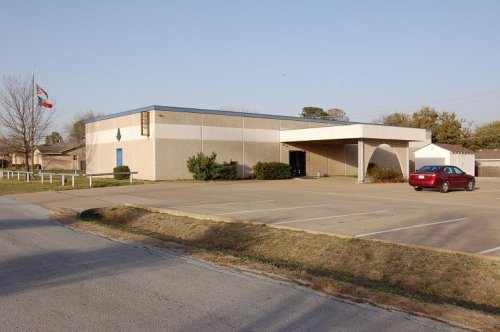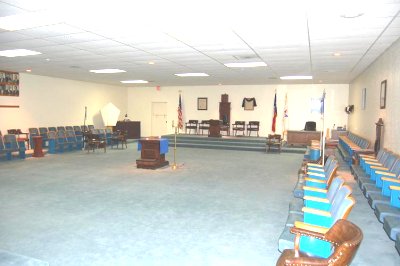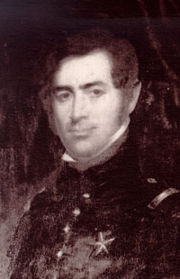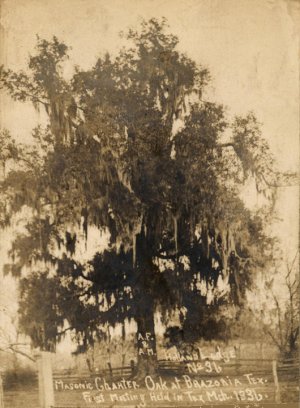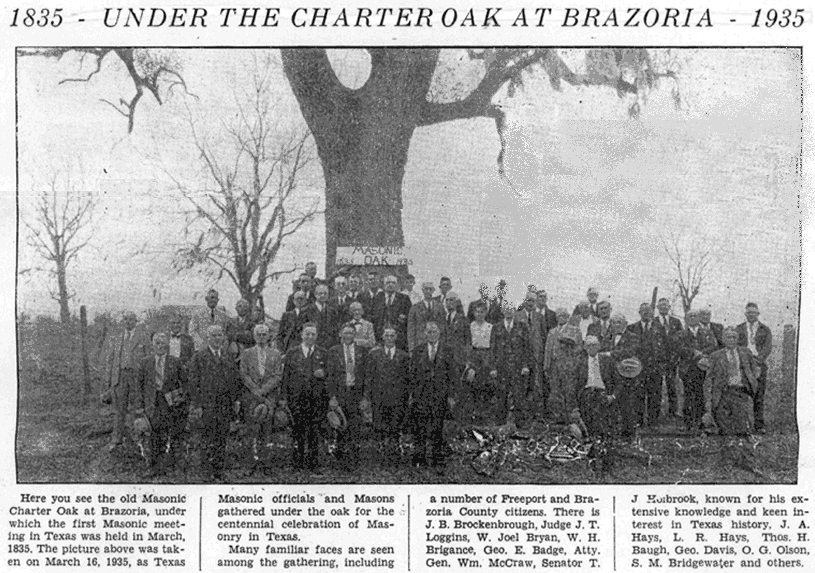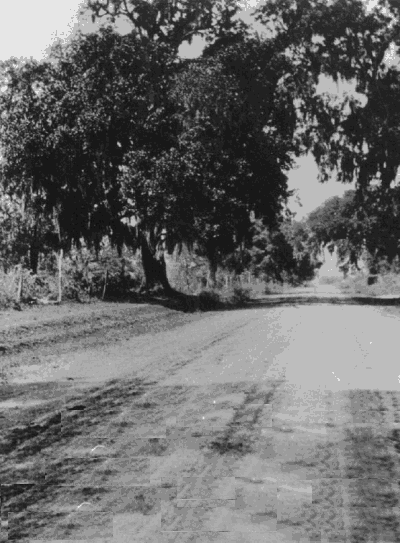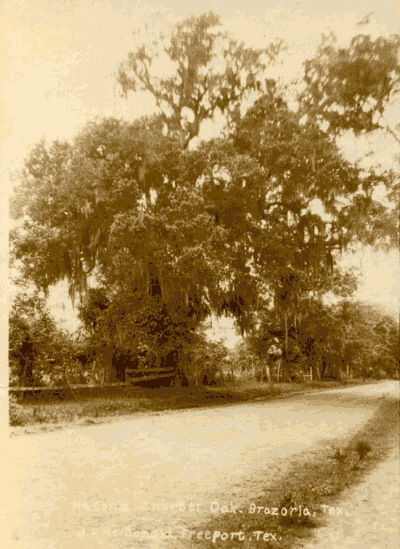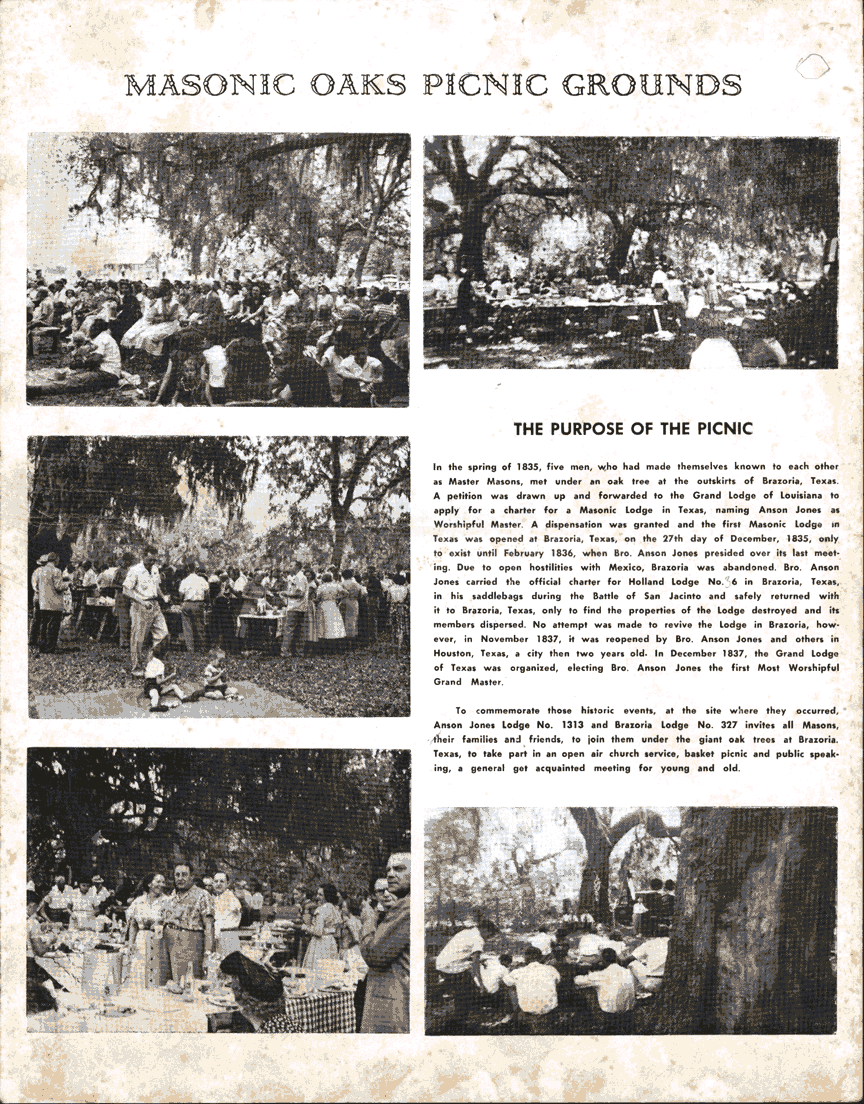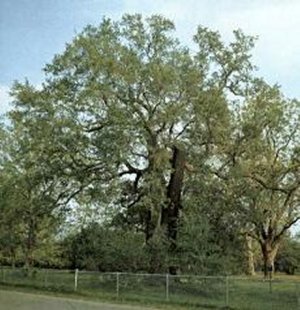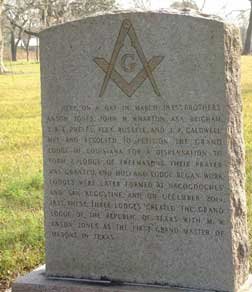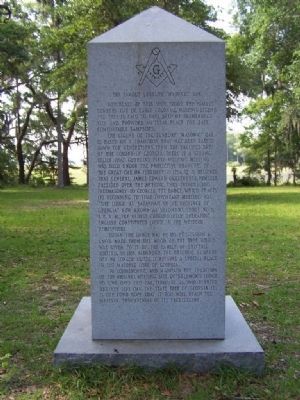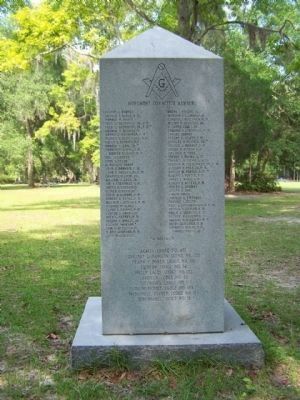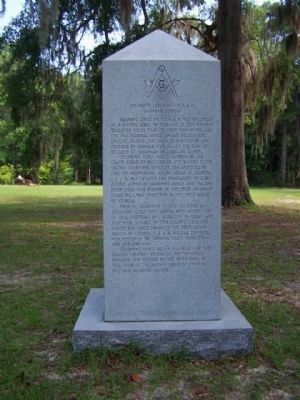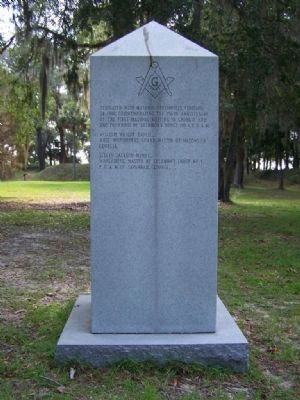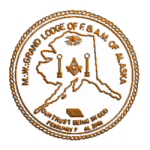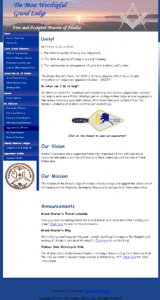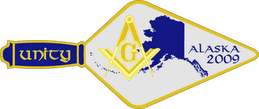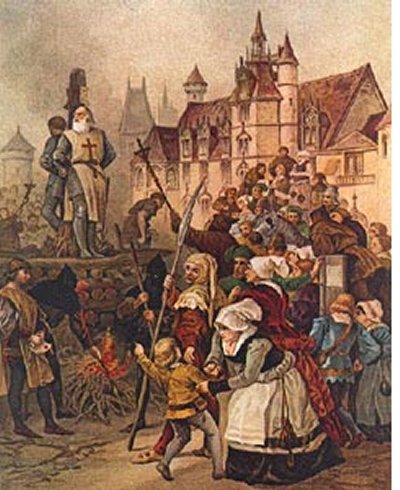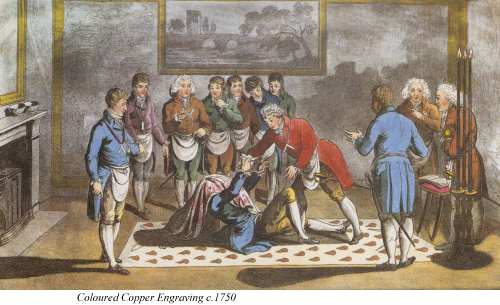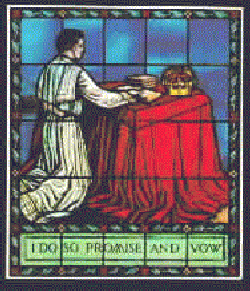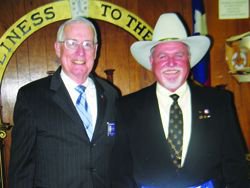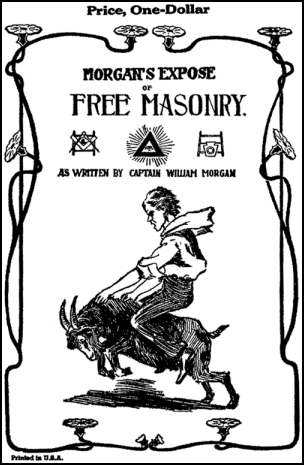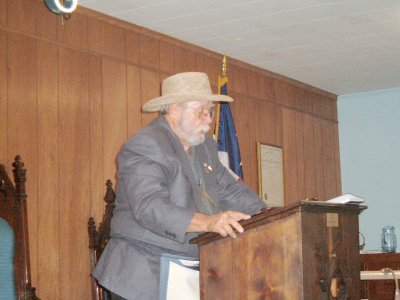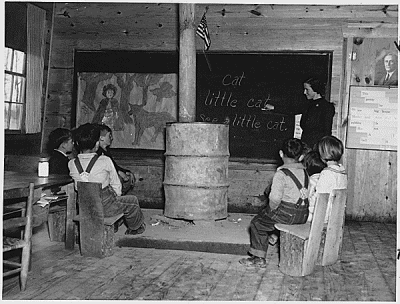
|
June 2009

Lewisville Masonic Lodge No. 201 AF & AM
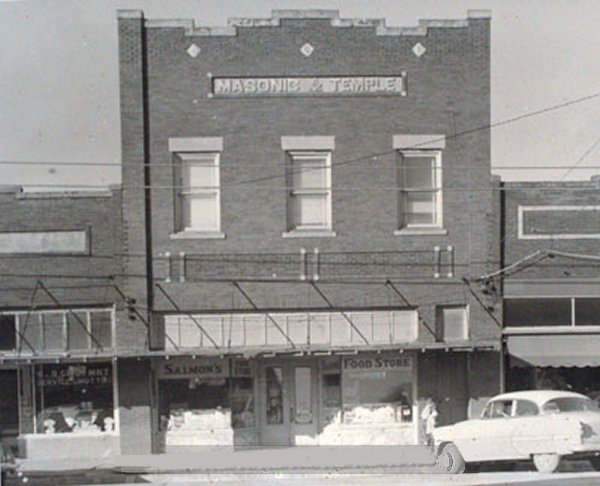 The Lewisville Masonic Lodge No. 201 AF & AM - Circa 1950 |
|
Page III | ||
|
In 1841 The Republic of Texas gave an empresario grant to twenty American and English investors led by William S. Peters, this land became known as Peters Colony. Over the course of the next nearly twenty years, Peters Colony encompassed all or part of nine counties in north central Texas. Within Peters Colony, The Town of Flower Mound was established soon after Sam Houston settled a tribal dispute in 1844 and Indian raids in the area ceased. Situated in the south central portion of Denton County, it was named for a fifty-foot high mound covered with Indian paintbrush; Indians once used the mound as a holy place. Within the next couple of years, Freemasons who were among the early settlers in the surrounding area began holding unofficial meetings in varying locations. One of these locations was known as Mason's Hole and is said to have been located along Prairie Creek, North of Main Street and West of I-35. A map of early settlements in the area shows a Masonic meeting place near Prairie Creek in 1846. Shortly thereafter, in 1853 the adjacent town of Lewisville was established by Basdeal W. Lewis after purchasing the property previously know as Holford Prairie, also a part of what had been know as Peters Colony.
The John B. Denton Lodge continued to meet at the Flower Mound school until June 13, 1859 at which time, The Grand Lodge of Texas brought attention to the fact that the Lodge was not meeting in a suitable building and steps were taken to erect a more permanent home. Accordingly, the Lodge moved to “Old Hall Cemetery” where a new two-story building had been erected. This was the earliest permanent home of John B. Denton Lodge. During the Civil War a company was mustered into the Confederate service at the “Old Hall Cemetery.” The building at “Old Hall Cemetery was erected by both the efforts of the Lodge members and the members of first church in the area. This new building also housed the public school in Lewisville and was described as a “pretty roomy affair” by J.H. Donald in an interview in August 1930. In 1871 the Lodge purchased a piece of property at the corner of College and Cowan street and erected a new two story Lodge building which was also used as a school, called the Lewisville Masonic Institute. In 1890, John B. Denton Lodge’s name was changed to Lewisville Lodge No. 201, to help eliminate the confusion with Stanfield Lodge No. 217, located within the city of Denton. In 1891, the property upon which the temple now stands was purchased and a two-story structure was erected with the bottom portion used as a grocery store and the upper as the meeting hall for the Masonic Lodge. This structure burned during a fire, which swept through the north side of town on August 4, 1918. Furthermore, all the Lodge records and that of the local newspaper were also destroyed in the fire. The joint property owner rebuilt what was then a grocery store on the ground floor but it was not until 1920 that the Lodge had sufficient funds to remove the roof and rebuild the second story. The ground floor of the building continued to house various business throughout the coming years while the second story continued to serve as the home of the Lewisville Masonic Lodge until 1981 at which time the present Lodge at 603 Manco was erected. During this era, many changes came about. There were good times, and good fellowship, and there were also some rough times when the Lodge was hard pressed for finances. But we endured, and our members always gave freely of their time and talent to keep Masonry alive in this community. The proof of this surrounds us today as we view our present, beautiful temple, completed during 1981, and which was erected as those before, with the labor, materials, and money contributed by our members.
Furthermore, many non-Masons also gave generously in order that our Masonic Lodge could add its pillar of strength to the community.
|
|
Page IV | |
"Who Will Follow Old Ben Milam?"
Benjamin Rush Milam was born in Frankfort, Kentucky, on October 20, 1788. He grew up in Kentucky and served in the War of 1812. In 1815, when he and two partners chartered a schooner to take a load of flour to South America, the Captain and most of the crew died of yellow fever, and the rest were nearly killed in a storm.
Milam went to Texas in 1818 to trade with the Comanche Indians. Among the tribes he met David G. Burnet who was living with the Comanche. The two men formed a friendship that lasted many years. In 1819 Milam joined the fight for Mexican Independence from Spain. Betrayed and imprisoned in Mexico City, he was released through the intervention of the American Minister in Mexico City, Joel Poinsett, who was also the man who introduced York Rite Masonry into Mexico.
From 1825 to 1826, Milam was Arthur Wavell's partner in a silver mine operation in Nuevo León. The two also obtained empresario grants in Texas. In 1829, Milam intended to organize a new mining company in partnership with David Burnet, but failed due to a lack of funds. In 1835, Milam went to Monclova, the capital of Coahuila y Texas to urge the new governor, Agustín Viesca, to send a land commissioner to Texas to provide the settlers with land titles. However, before Milam could leave the city, word arrived that Antonio López de Santa Anna had overthrown the representative government of Mexico and established a dictatorship. Governor Viesca fled with Milam, but both were captured and imprisoned at Monterey. Milam eventually escaped, thanks to sympathetic jailers who gave him a horse and let him escape.
By chance, he encountered a company of Texas soldiers commanded by George Collinsworth, from whom he learned of the movement in Texas for independence. Milam joined them, helping to capture Goliad. He wrote: I assisted Mexico to gain her independence. I have endured heat and cold, hunger and thirst; I have borne losses and suffered persecutions; I have been a tenant of every prison between this and Mexico. But the events of this night have compensated me for all my losses and all my sufferings.
He then marched with them to join the main army in capturing San Antonio. On November 18 Stephen Austin resigned command of the Texan forces at San Antonio to fulfill his mission to the United States as a commissioner. Edward Burleson was elected on November 24 by the volunteers to take Austin's place.
While returning from a scouting mission in the southwest on December 4, 1835, Milam learned that a majority of the army had decided not to attack San Antonio as planned, but to go instead into winter quarters. Burleson and his council of officers were reluctant to attack, and next day at 3 p.m., Milam went to Burleson’s tent and to ask permission to call for volunteers to storm the city. Burleson had little choice but to go along with Milam's plan. Milam was convinced that putting off the final assault on San Antonio would be a disaster for the cause of independence. He then made his famous impassioned plea: Who will go with old Ben Milam into San Antonio? Three hundred volunteered to attack at dawn on December 5.
The Siege of Bexar
Plans were quickly made. The men would form at an abandoned mill, Molino Blanco or Zambrano's mill, at three a.m., while Burleson was to hold the rest as a reserve. At the same time, Captain James C. Neil was to open fire with two cannons on the Alamo to distract the Mexicans soldiers.
On December 7, 1835 Milam, standing with Frank Johnson and Henry Karnes near the Veramendi house, was shot in the head by a Mexican rifleman and killed instantly. He had been trying to observe the San Fernando church tower with a field telescope given to him by Stephen Austin. Robert Morris was chosen to take over Milam’s command of the first division.
The Mexican Army lost more than 400 killed, deserted or wounded in the ensuing battle. Texan losses were only 20 to 30 killed. The siege ended on December 9, 1835 when Martín Perfecto de Cos sent a subordinate to negotiate a truce with the Texans. Morris gave Cos and his troops six days to leave the Alamo. Burleson provided the Mexican Army with such supplies as he could spare, and the Mexican wounded were allowed to remain behind to be treated by Texan doctors.
Colonel Edward Burleson recorded in his diary that Milam was buried with Masonic honors in the courtyard of the Veramendi Palace. He was a member of Hiram Lodge No. 4 at Frankfort, Kentucky. |
|
Page V | |||||
The Masonic Oak - A Photographic Journey By John "Corky" Daut PM Editor STTME-mag
It is said that from little acorns, mighty oaks grow. Such was the case in about the year 1600 when an acorn fell to the ground in the vast coastal forest area near the present City of Brazoria. It was an acorn from which to grow a tree destined to play a part in the history of Masonry in Texas. When the first colonist arrived in Texas their life was one of survival without the benefit of churches, schools and lodges, or even homes as they put together shanties of one kind or another until they could find the time and means to build something more substantial.
In 1828 the government Of Mexico, including many Freemasons, knowing the political philosophies of the liberal elements of English-speaking Freemasons were afraid that Freemasonry could influence the Texans to try to gain independence. To combat that possibility, the Mexican government outlawed Freemasonry on the 25th. of October of that year. In 1829, Austin called another meeting of Masons with the idea of trying to lessen the fears of the Mexican government. It was decided however, that due to the current conditions in Mexico, it would be "impolitic and imprudent at this time to form Masonic lodges in Texas.". In March of 1835 a small group of Freemasons including Brothers Doctor Anson Jones, John A. Wharton, Asa Brigham, James A. E. Phelps, Alexander Russell started a meeting and were soon joined by Brother J. P. Caldwell. These men, who having made themselves known to each other as Masons, had gathered to discuss the need for a Masonic Lodge in in the republic of Texas. The meeting was held under the shade of a majestic oak tree in a secluded, area near the Brazos river, an area out of the way of cowans and eavesdroppers. After organizing, a petition was sent to the Grand Lodge of Louisiana . On December 27, 1835, after the dispensation from Louisiana had been granted, the first meeting of Holland Lodge No. 36 was conducted That charter, creating Holland Lodge No. 36, was issued and signed on 27 January 1836. It was given to John M. Allen of Louisiana Lodge No. 32 to carry to Texas. Allen had been recruiting volunteers for the Texas Army in New Orleans, and would not reach Texas until just before the Battle of San Jacinto on 21 April 1836. The charter was eventually given to Brother Anson Jones just before the battle at San Jacinto, and he carried it in his saddlebags until after the battle.
|
|
Page VI | ||||
|
The Masonic Oak - A Photographic Journey Continued From Page VI
The first annual Masonic Oak pilgrimage and basket picnic in was organized in 1949.
"Here on a day in March 1835 Brothers Anson Jones, John A. Wharton, Asa Brigham, J.A.E. Phelps, Alex Russell and J. P. Caldwell met and resolved to petition the Grand Lodge of Louisiana for a dispensation to form a Lodge of Freemasons. Their prayer was granted and Holland Lodge began work. Lodges were later formed at Nacogdoches and San Augustine, and on December 20th, 1837, these three Lodges created the Grand Lodge of the Republic of Texas with M.W. Anson Jones as the first Grand Master of Masons in Texas." Credits
Special thanks to Michael Bailey, the Curator of the Brazoria County Historical Museum for allowing us to display these photos from their current exhibit featuring some significant live oak trees from the area. The Brazoria County Museum is located in the 1897 Brazoria County Courthouse at 100 East Cedar Street in Angleton. It is open weekdays from 9 a.m. to 5 p.m. and on Saturdays from 9 a.m. to 3 p.m. It is closed Sundays and holidays. Admission is free. For more information, call 979/864-1208 or visit the Museum's website at www.bchm.org. It includes exhibit spaces, an auditorium for programming, the Museum bookstore and the Adriance Research Library.
Thanks also to the Grand Lodge of Texas web site and the Wikipedia Web Site
|
|
Page VII | |||||||||
In Liberty County, Georgia In 1733, a number of Masons under the leadership of General Oglethorp, while at Sunbury, organized a Lodge known afterward as the Savannah Lodge under a large oak tree.. This Lodge was chartered, in 1735, as Solomon's Lodge.
Reprinted From HMdb.org THE HISTORICAL MARKER DATABASE
Inscription. [West Face]:
The legend of the Sunbury "Masonic" Oak is based on a tradition that has been passed down for generations from the earliest days of the Colony of Georgia. There is a strong belief that Georgia's first Masonic meeting was held under the protective branches of the great oak on February 21, 1734. It is believed that General James Edward Oglethorpe, himself, presided over the meeting, thus introducing freemasonry to Georgia. The lodge which traces its beginning to that improtant meeting was "The Lodge at Savannah in ye province of Georgia" now known as Solomon's Lodge No. 1, F. & A.M., the oldest continuously operating English constituted lodge in the western hemisphere. Today the Lodge has in its possession a gavel made from the wood of the tree, which was given to it by the family of Sheftall in 1859. Aothough the original Sunbury Oak no longer exists, it retains a special place in the Masonic lore of Georgia. To commemorate and maintain the tradition of the original meeting site of Solomon's Lodge No. 1, we have this day, February 24, 1990, planted another live oak, the state tree of Georgia. It is our fond hope that it too will reach the majestic proportions of its predecessor. [North Face]:
[East Face]:
Solomon's Lodge No. 1, F. & A.M. was organized as a Masonic Lodge on February 21, 1734. Masonic tradition holds that its first worshipful master was General James Edward Oglethorpe, English soldier, statesman, humanitarian, and founder of Georgia, who raised the flag of England at Savannah on February 12, 1733. Solomon's Lodge was chartered by the Grand Lodge of England in 1735, making it the second chartered lodge in the Americas, In 1786, the Independent Grand Lodge of Georgia, F. & A.M. was created and proclaimed by concerted action of Solomon's Lodge and the one other lodge then existing in the State. Solomon's Lodge No. 1 was chartered as the first lodge of Georgia. From its beginning in 1734 Brethren of Solomon's Lodge have served with distinction in vital positions of leadership in public and fraternal affairs of city, colony, state and nation. The Lodge produced the first Grand Master of Georgia, F. & A.M., William Stephens, who governed the Georgia craft from 1786 - 1788 and 1793 - 1813. Solomon's Lodge No. 1, F. & A.M., on of Savannah's greatest historical institutions is honored and revered by the Freemasons of this state as the Mother Lodge of Georgia, Free and Accepting Masons. [South Face]:
William Wright Daniel,
Steven jackson Myhre Erected 1990 by Solomon's Lodge No. 1, F. & A.M. of Savannah, Georgia. Location . 31° 45.702' N, 81° 16.887' W. Marker is in Sunbury, Georgia, in Liberty County. Marker can be reached from Fort Morris Road. Click for map. Marker is near the entrance to Fort Morris Park, off Fort Morris Road. Marker is in this post office area: Midway GA 31320, United States of America. Other nearby markers . At least 8 other markers are within 5 miles of this marker, as the crow flies. Fort Morris (about 400 feet away, in a direct line); The Old Sunbury Road (approx. 0.4 miles away); Sunbury Cemetery (approx. 0.6 miles away); a different marker also named The Sunbury Cemetery (approx. 0.6 miles away); Sunbury (approx. 0.6 miles away); Saint John's Lodge Number Six (approx. 0.6 miles away); The Dead Town Of Sunbury (approx. 0.6 miles away); Dorchester Village (approx. 4.2 miles away). Click for a list of all markers in Sunbury. Credits . This page originally submitted on July 23, 2008, by Mike Stroud of Bluffton, South Carolina. This page has been viewed 963 times since then. Photos: 1, 2, 3, 4. Submitted on July 23, 2008, by Mike Stroud of Bluffton, South Carolina. • Kevin W. was the editor who published this page.
| |||||||||
|
Page VIII |
|
By John "Corky" Daut Editor STTME-mag.
Every now and then a Brother or a friend asks me how I became connected with Freemasonry so late in life. I feel a good answer is in a letter I wrote not long after being raised.
To; Mr. W. N. Daut On a somewhat related subject, there are a number of people who believe that "orbs" in photographs are spirts of departed people. I neither believe nor disbelieve. However, I still wanted to add this little story. The picture below was taken with a FUJIFILM FinePix A330, model digital camera around 8:15 pm on June 25, 2005. This photo was the last one of 33 pictures taken that night and has not been altered in any way except to increase the brightness slightly with Paint Shop Pro to make it easier to view as were the other 32 pictures.
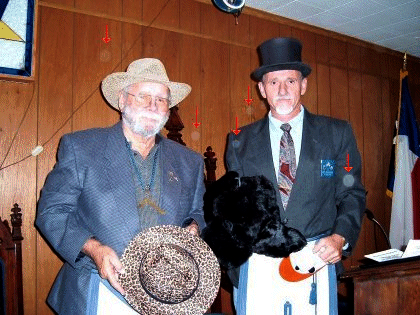 Corky On The Left Side. On June 25, 2005, Waller Masonic Lodge #808 AF & AM held an open public meeting to install the new officers for the next year. Of course almost everyone including myself, had friends and kinfolk there. I was being installed as Worshipful Master of the Lodge. OK I need to stop a moment and explain for non-Masons, the title "Worshipful" has nothing to do with worship. Remember, Masonry started in 1700s England and "Worshipful" is the old English term meaning "Respectful". Look it up in the dictionary. Anyway, I had prepared a short speech which included the following lines, "I regret that my dad never knew I was raised as a Master Mason after he died. I also regret that he couldn't be here to sit in Lodge with us at this time. He might have even been prouder then I am. He was a member of Cade-Rothwell Lodge for about 40 years until he died in 1982". For me, it was an emotional night and when I started reading those words, I choked up completely and stood there like an idiot not able to say anything for a couple of minutes.
After the ceremony ended, my sister came up and hugged me and whispered in my ear, "Don't worry brother, dad knows."
Later that night I downloaded the photographs (that my daughter had taken during the ceremony) into my computer to check them out. Out of the 33 picture she took that night, the last one she took, with me standing at the Master's station just after my speech, was the only one that had an orb in it. Actually, there were at least 5 orbs in that picture. |
|
PageIX | ||||||
The Grand Lodge of Alaska Reprinted With Permission Of The Author
About the Grand Lodge:
Alaska Grand Lodge History
Vision statement:
Alaska Freemasons are a respected fraternity comprised of men with high moral character who make a positive difference in their community and the lives of their fellow man.
Mission statement:
The mission of the Grand Lodge of Alaska is to encourage and support the advancement of Freemasonry in Alaska by developing Masons who are assets in their communities
Alaska does not have a listing on Wikipedia.
One thing I do want to make note of is that Alaska is probably the youngest of Grand Lodges in the United States.
Some of what I found on my excursion there:
Opening the website, the user is met with a very clean two column layout. The top has an image of the Alaskan landscape with the sun at the horizon (which has an interesting symbolic aspect perhaps implying the sunrise in the east). Immediately on the page is a message from the Grand Master for 2009 about Unity. This site itself is built with an HTML architecture, where the navigation is straight forward on the left and the content resides in the larger well on the right. This is a frequently used architecture, because it is often the most straight-forward as clicking on the left side navigation the new content populates the right.
The Grand Lodge of Alaska Website
From a navigation stand point, it seems that a missed opportunity here is to make each of the main areas: Home, Learn about Masonry, About the GL, Events, etc… into their own pages. That way, the content of the PDF could be laid into the page as text rather than a force to open/download file.
Informational Content:
When looking at the site from an informational stand point, I found that it was very robust, and all right at the top level of the navigation. It included aspects of Freemasonry and Religion, the Grand Lodge history, the Grand Officer line (including elected, affiliated, appointed, honorary, and past officer), and a list of “Masons of the Year”, and double list of state lodges by alpha and lodge number. It really covered its bases.
Also, it answers the 2be1ask1 question of how to become a Mason. Rather than employing the 2be1ask1 moniker, they come straight forward and have a link “How to Become a Mason”. Following the link sends you to a page with a link to a contact page; lodge connect page, and a “more info” link. As the prospect of the page started strong, it does lose the conversion appeal of the call to action (for more info!) immediately from that page rather it sends them out to another page with address, email and phone. This can be hard to change as it presumes that there is a mechanism in place to take in those contacts and manage them as they are received. This speaks to the broader organization (the back end of the site management) that necessitates some form of infrastructure to address any inquiries.
Look and Feel.
The Alaska Grand Lodge site is definitely informational driven and not based on art, which is fine. There were some good inclusions of artwork that highlight the state of Masonry in Alaska including the masthead, the state seal, the leadership, and the Grand Masters Trowel on the front page. Besides those hits, there was little use of art in the site. Where I did find the artwork was in the newsletter, which included a very generous application of fun images. I think that this was a great way to show off what the state of Alaskan Masonry was about. My only recommendation is to move the newsletter content out of the PDF, and into the website which makes it more accessible and user friendly. Why hide the photos of Masons on trips, in boats (or the goat with the saddle for that matter) when they show off what's going on.
Overall:
Coming up next - The Grand Lodge of Arizona.
|
|
Page X | |
A Masonic explanation by Tore Akesson
The following, historical events, 700 years back in time, are related to peoples fear for the number 13 and Friday the 13th. It arrived to America and was spread all over the world by French emigrants, who heard of the tragedy in France and especially in Paris, below shortly described:
The tragedy concerns the banishment, arresting and outlawing of all Knights Templar, Friday the 13th of October, the year 1307 against their declaration of innocence.
When the flames from the stake, where he was tied up, reached him and it started burning in his dress, he proclaimed in front of the assembled Parisians: "Here you see innocent people die!" Then he turned toward his three present executioners with the following cry of prophecy, (compare the First Epistle of the Corinthian, 14:1): "I am calling you, King Philip IV of France!" "I am calling you, Pope Clemence V" "I am calling you, Prime Minister Guillaume de Nogaret, to appear within one year from today at the Court of God in order to receive your legitimated penalty! - curse, curse, be all of you cursed until your 13th generation" Then he fell dead down in the ashes and the red hot coal of the stake with his forefinger upright to the Heaven of God. The arm and the hand with the upright forefinger stayed in this position. The Parisians thought that this prediction was also valid for them and therefore the fear for number 13 and Friday the 13th started to expand out over the world. But the prediction did not concern the innocent Parisians or other human beings then the three judges and their families. The King fell off his horse and died before end of the year. The Pope got an intestinal obstruction and died before the end of the year and the Prime Minister hung himself before end of the year. Their three families are reported to have lived in misery ever since. Our generation can be regarded as the 13th. The sign of the Grand Master with the upright forefinger figures often in paintings of Leonardo da Vinci e.g. in the large painting of the last supper in the St. Maria delle Grazie Church in Milan, Italy. One of the Disciples of Jesus is doing this upright forefinger sign, like originally the Grand Master, in order to show the divine consequence of treachery like when Jesus said: "One of you shall betray me!" The prediction of the Grand Master of the Knights Templar for the King of France, The Pope and the Prime Minister to appear in the Court of God within one year, was a prophesy as per the First Epistle of the Corinthian, 14:1 and a result of accepting the death penalty rather then to fail in chivalry against his Brothers or break the monk vow , the vow of loyalty to the Roman Church and the vow of friendship and love for his neighbours. The family of the undersigned holds in our position an oil painting, showing this last known Grand Master of the Knights Templar in front of representatives of his judges in the presence of the Captain for the 100-man guard force and the Castle Marshal in the Temple Tower in the Le Temple in Paris. The subject in this painting is built as those of Leonardo da Vinci when illustrating historical events. Consequently this painting can be a work of him or a work of one of his scholars who wanted to illustrate this tragedy. It is unsigned due to the death penalty at the time for critical publishing of governmental, official judgmental events, a result of a ban etc. The Castle Marshal on this painting hold his forefinger upright to the Heaven of God, based on the same type historical prediction of Jesus, but now spoken by Jacques de Molay: "We are innocent!". The Castle Marshal, also prison-warder during the Knights Templar control of the Castle, shows with his upright forefinger the incorruptible law of God that will take force, harming innocent people. No other painting has been able to make such a strong impression on me, the undersigned, when it comes to human rights, the importance of chivalry and the importance of love and mercy to my neighbours, as this painting. The painting shows namely the moment when the Grand Master just decided to stick to the chivalry and to his taken vows, resulting in the death penalty. He has namely just thrown the officials, obviously false writing of confession in peaces which should have saved his life. But he has just thrown the peaces on the floor in front of him, as unacceptable. As the Knights Templar esteemed great confidence among the public and the terrible tragedy of the Knights Templar was generally revealed among the public, the fear for number 13 and Friday the 13th started to spread. This fear is still going on even if the original background might be forgotten. The following religious comment to the importance of number 13 is made by Emanuel Swedenborg who spend 30 years of his life in explaining the Christian bible: Number 13 consist of number 10 and number 3. Number 3 is a holy number and as it is part of number 13, the holiness of number 13 remains.
Was the Grand Master Jacques de Molay aware of this holiness of number 13? Did he know that 3 persons with 3 families should suffer in 13 generations? This is a question for each one of us to consider and answer. For me it is obvious, because the truth fell out right as the prediction. Therefore number 13 shall not be related to fear and curse but to happiness and blessings. For me number 13 is my lucky number. Remembering how the fear and curse once was established and spread all over the world, I will be filled up with love and mercy for the man, who dared to stay on his chivalry, monk vow, the vow of loyalty to the Roman Church and the vow of friendship, love and mercy to his neighbours, and face the dead penalty without fear. Thus the number 13 became the number of chivalry and uprightness.
|
|
Page XI | ||
"Where is the spirituality, the attempt at self-improvement, the journeys into symbolism,... into the unexplained?"
Try this and see how it fits. Freemasons belong to an organization which ought to be dedicated to self-knowledge, the nature of being, love, tolerance, the brotherhood of man, liberty of conscience and, yes, perhaps a brush with the Deity on the way. But we have become bogged down in systems resembling officialdom, obsession with promotion to higher rank, discussions about precedence, confused notions about God, the relative merits of this or that dining venue and the parroting, without meaning, of what is in itself a very meaningful ritual. Perhaps worst of all we call ourselves a charitable organization, when what we are is, primarily, an organization with all the attributes I have mentioned plus, in addition, some philanthropic ones.
Where is the spirituality, the attempt at self-improvement, the journeys into symbolism, the journeys, come to that, into the unexplained, both without and within? If we examine where freemasonry in England is at the moment, to put it bluntly, we are engaged in initiating ever more men into the craft and conferring second and third degrees on them, so that they shall in their turn be Appointed To Office In The Lodge, In Due Time Becoming Worshipful Master. To what end? The end, unfortunately, is so that they can then confer initiation on more men, so that those men can then do the same to other men, usque ad infinitum. We seem to do this under the justification of "a daily advancement in Masonic knowledge." Is it too much to ask what advancement? What has happened to them? How has freemasonry shaped their lives, if at all? Have they grown, and if so, in what way? What have they learned? These are not rhetorical questions, because to some of these brethren something has happened; freemasonry has shaped their lives, even if only in a small way; they may indeed have grown, without knowing it; they have almost certainly learned something, even if it is only some ritual learned by default. But for many of us, I suspect, the eternal conferring of degrees very soon becomes an end in itself.
It's easy to forget that freemasonry in the eighteenth century was a radical movement, often standing against abuses of power on the part of the Establishment. Its development and growth were a vital part of the Age of Enlightenment. It was, for many, the route to knowledge denied to them by an oppressive religious or political system. Yet after a recent talk on education in freemasonry, when I asked the speaker whether it would be possible to include talks on historical or philosophical matters as a regular feature of lodge proceedings (such as are commonplace in many continental lodges), the reply was that "this would not suit the majority --- after all, people enjoy their freemasonry on many different levels", a knife-and-fork mason's charter if ever I heard one.
The good news is, it doesn't have to be like this. As Colin Dyer points out, the proper means of instructing young masons is not by repetition of degree ceremonies, but by the various systems of Masonic lectures. In the late 18th. and early 19th centuries lodges of instruction did not teach degree ceremonies, so much more engaged were they in moral and philosophical debate. Masons were often `made' outside the lodge altogether, and then brought to the lodge where their real work started, in moral, intellectual and spiritual pursuits. Degree ceremonies, by contrast, are only the means (however ornate) of making masons and advancing them to other degrees once they have learned something. Degrees of what? To attain to a higher degree, surely you have first to study, to learn, to gain proficiency.
When I first wrote this, I had in mind the experiences of one or two of our younger brethren, whose second and third degrees came quite a while after their initiation. They expressed surprise that they were not expected to make a more taxing advancement in Masonic knowledge, and seemed bored by the lack of activity; in short, they felt abandoned. I have a keen sense that they were right to feel this way.
So how about it? What is our daily advancement in Masonic knowledge, and how to we go about this business of self-knowledge, inner growth, or is it all just empty words? |
|
Page XII | |
By H. L. Haywood
Again - and to continue asking questions - why do about one-half of the 49 Grand Lodges in the United States style themselves as Ancient, Free & Accepted Masons, whereas the others, with only one or two exceptions, style themselves as Free & Accepted Masons, omitting "Ancient"? Why do the members of our Fraternity call themselves Freemasons instead of Masons? It once again brings to the front the question as to what the "free" means. In his history of our Craft J. G. Findel states that he had found the name "Freemason" used as far back as 1212. G. W. Steinbrenner, who also wrote a book on the origins of our Fraternity, gave 1350 as the earliest date on which he had found the name. In his famous essay on "free" in Freemasonry R. F. Gould, the Craft's premier historian, gave 1376 as the earliest use of the name known to himself; it was in a record belonging to the Mason Company of London. One of the very earliest uses of the name in British law occurred in a statute dated in 1459. At the time of writing, the earliest known use of the word "Freemasonry" in a printed book is in a small work by William Boude, in the British Museum, published in 1526. It appeared in another printed book, a quaint volume entitled A Most Precious and Spiritual Pearl, published in 1550; and yet again in a small child's book, Dives Pragmaticus, published in 1563. The name occurs more frequently in seventeenth century printed books. It must have been everywhere the recognized name for the Fraternity by the time the Mother Grand Lodge was organized in 1717, because it was used as a matter of course on the title page of the first edition of the Book of Constitutions published by that Grand Lodge in 1723, in the form of "Free-Masons." During many centuries throughout the Middle Ages builders of all kinds were called masons, but a special class of them was called freemasons. The question is, why that distinction? It is an exceptionally difficult question to answer - possibly it is the most difficult single question in all the fields of Masonic history, scholarship, and research. That question is complicated by the fact that among a number of other crafts the members of certain gilds, or associations, also called themselves "free." (Unless I have been misinformed, there is in Germany, or was until the last War, a large society which called itself "The Free Carpenters.") In the great treatise which he contributed to Ars Quatuor Coronatorum, Vol. X, page 10, George William Speth gave a representative list of them. Among them were such as the following; Free Carmen, Free Fishermen, Free Dredgers, Free Watermen, Free Vintners, Free Butchers, Free Scriveners, Free Printers, Free Sawyers, Free Carpenters, Free Sewers (tailors). Did these gilds and craftsmen call themselves "free" for the same reason that the freemasons did? Speth did not believe so. (A branch of the German secret society called Freesmiths was set up in Baltimore, Maryland, in 1865.) Difficult as the question is, however, the scholars of the Craft, and more especially the historians, have never ceased in their endeavors to solve it. I shall set down a representative list (though not an exhaustive one) of the theories to which their findings have led them. In doing so I shall make the paragraphs on each one as brief and as simple as possible, and not overload them with references to books.
1. The "liberal arts" theory. During the Renaissance, men in the fine arts often were called "free." The word was used in the same sense as "liberal" in such phrases as "the liberal arts," "a liberal education." In the organized handicrafts men worked together in an organization, and according to fixed rules, but a man in the fine arts was a creator, who made use of himself to accomplish his tasks, therefore he had to be left free to follow his own ideas, inspiration, and skills. In a paper contributed to Ars Quatuor Coronntorurn, Vol. II, page 141, F. F. Schnitzger argued that freemasons were called "free" because architecture was a fine art.
|
|
Page XIII |
|
Continued From Page XII
6. The "Speth" theory. No other theory has ever occasioned so much discussion as this because at the time he published it in the tenth volume of Ars Quatuor Coronatorum the members of that first of lodges of research were the giants of modern Masonic scholarship, and Speth was the secretary of the lodge itself. That his paper was a masterpiece was freely granted even by those who could not accept his theory. Speth argued (I reduce his theory to very few words, and therefore run the risk of robbing it of half its weight) that in the Middle Ages there had been two kinds of gilds of builders. On the one side there were the local, or stationary, gilds, composed of workmen who could construct simple buildings, the members of which were by law compelled to remain within their local boundaries and were not free to work elsewhere. On the other side were the builders of churches and cathedrals who were free to work anywhere, and who, once they began a structure, could set up their own lodges. They were free from the restrictions of local gilds, and for that reason were called freemasons. Speth summed up his own theory in a few words: "The fact remains that we, of today, are the sons of the freemasons and not of the gild masons."After much traveling about in the literature of which the above seven paragraphs give but the slenderest of indications, I find that in my own mind there remain three observations which, though they can settle nothing, may not be unworthy to be added to the discussion. 1. As far as the origins of the word "freemason" are concerned there are indications in the records in sufficient number to suggest a theory unlike any described in the paragraphs above. It could be named the "coincidence theory." At some given time, in some given place, in a part of Scotland, say, or in one of the counties of England, craftsmen were called freemasons for one reason; at another time, perhaps a century afterwards, and possibly in France, they were called freemasons for reasons of a wholly different kind. That these different reasons resulted in the same word was a philological coincidence. The word "mystery" is one example of such a coincidence, because it had three different origins; the word "rank" is another, because it had two. |
|
Page XIV | |
|
Candie Beck-Adams Ennis Daily News Ennis TX
When many people think of the Masons, images of movie scenes from “National Treasure” and “The Da Vinci Code” may come
to mind. However, that image is just what members of the Ennis Masonic Lodge were hoping to change with the open meeting
they held last week for the community.
“There are a lot of ideas out there and while some of them are accurate, some are definitely not and we wanted to share who we are with the community to help clear up some of the misunderstandings,” he said. “We also wanted to dispel some of the rumors and myths that are attached to the Masons.” Hackney shared a history of the Ennis Lodge with those in attendance and dated the lodge to the same year the city was founded. “The city and the lodge were both founded in 1872 and we know that some of the city's founding fathers were also members of the Masonic lodge and we are very proud of that history,” Hackney said He also shared that the earliest date on record of the Ennis lodge being at its present location of 209 N. Dallas St. was in 1909. The lodge was moved several times prior to that date due to the destruction of buildings from fires. After Hackney's introduction to the Ennis lodge, keynote speaker Elmer Murphey III spoke about the customs and practices of the Masonic lodge. He described the group as a simple organization of men that strive to be the best they can be and help their communities through their actions. “Talking about the Masons is a natural thing for me because it is my passion,” he said. “We are a simple group whose beliefs and so called secrets are based on the principles found in the Bible. All of our teachings can be found or read from there, but because we do not volunteer that information we have a reputation of being a secret group. Murphey went on to explain that the Masonic group has the distinction of being the only corporate body that is allowed to form other corporations without the permission of the state. The group is a 501-C10 fraternity, which is a non-profit, individual corporation that only needs the permission of the Grand Lodge of Texas to form new lodges or corporations instead of the signature of the secretary of the state of Texas. For anyone wishing to join the Masons, Murphey outlined the three characteristics prospective candidates must have:
• Candidates must have a belief in a supreme being.After a candidate has made their petition to become a member, several members of the group lead an investigation into the character of the person making the petition. A visit is made to the person's home and conversations with the candidate's family are held. The members of the investigation give their report to the rest of the lodge and a vote is taken to either accept or reject the candidate from the group. All members cast a secret vote by placing either a white ball (to signify an affirmative vote) or a black ball (to signify a negative vote) inside a box and when everyone has voted the box is checked to see if there are any black balls. As long as there are less than three black balls, the petition is granted. Murphey attributed the recent influx of younger members to the organization to the fact that the group has remained the same since its inception and that the core principles of the organization remain intact. “I believe the rebirth of the lodge with younger members is because our principles remain constant,” he said. “Our traditions and values have remained the same and that is appealing to people. While times have changed and the world around us, our group remains steadfast in their beliefs and traditions.” The Masons are also known for their charitable work and strive to keep their affiliations such as the Scottish Rite Hospital free to any child that needs care. They also had an orphans and widows home in Fort Worth until 2005 when after 106 years of service, the last graduating class, the Mighty Mites, held commencement ceremonies. The group still has about 22 widows they care for at a facility in Arlington. The issue of why the group was still a men's only organization was addressed at the meeting and other alternatives were given for women wanting to become affiliated with the organization. “Women are not permitted in our group because when the group was started its members were actual operative masons, which did not include women,” Murphey said. “Our traditions and beliefs have stayed constant to the original workings of the group and we remain a men's group. However, organizations such as the Order of the Eastern Star is a counterpart to the Masons group and is a way any interested ladies can participate.” The group also has the Rainbow Girls of Texas, which includes girls that want to participate without needing a relative that is involved in the Masons group.
For more information on the Masons group, visit the Grand Lodge of Texas' Web site at
www.grandlodgeoftexas.org
|
|
Page XV | |
|
Warwick Beacon Warwick RI
The incident began in upstate New York, at a time that most people living on the frontiers of the United States were seeking to leave the past behind. For most, it was poverty and the lack of opportunities to succeed in more established parts of the East Coast but for others, the past they endeavored to put behind them had bankruptcy or possible prison time attached. Upstate New York was still the frontier when the “Morgan Affair” took place, and many of its participants took their questionable ethics to the relatively clean state of the countryside. Some of these characters became Masons. “Hoodlums and petty local bosses in the small towns of up-state New York in 1826 happened in many cases to be Freemasons,” wrote Jasper Ridley in his excellent book about Masonry, “but they continued to act like hoodlums and petty local bosses.” The hoodlums were on both sides of the issue in the Morgan Affair, and it is just as much a black mark on American history as it its on the history of the Masons. The anti-Morgan faction, mostly law enforcement officials in the area, had no compunction about looking the other way when fellow Masons attempted to suppress the local publication of Morgan's book, a book that promised to reveal all the shadowy rituals, oaths and obligations that Masons assumed. Morgan and his publisher anticipated healthy sales of the book to a public that had already developed a taste for writing about sensational things and Morgan was the man to give it to them. William Morgan was born in Virginia and roamed around the fringes of new settlements plying a variety of trades. Ironically, he was working as a stonemason when he joined the Freemasons. He called himself “Captain Morgan” and claimed to have provided distinguished service to the American cause in the War of 1812, but most doubted he had ever been in the army. He quarreled with and quit the Masons and then boasted of writing a book exposing Masonic secrets and a large advance paid to him by a local publisher. The Masons responded with personal attacks on Morgan's character in paid advertisements and a boycott of publisher David C. Miller's newspaper. It was no secret that the Masons planned further action and Miller's faction armed itself in anticipation of an attack on his printing establishment. Captain Morgan disappeared sometime after that and set off a raft-load of conspiracy theories with the Masons in the dead center of them. The misdeeds of Masons in the affair were regrettable but true. The alleged murder of Miller was never proven to have happened, let alone tied to the Masons. The most probable explanation is that Morgan was bribed to leave the country and he boated over to Canada with Miller's advance and a generous endowment from the Masons and assumed yet another identity. Sovereign Grand Commander John W. McNaughton (33 Degrees) prefaced this month's magazine with a plea for Masons to finally put the “Morgan Affair” behind them as they reach out for new members. “The Anti-Masonic Party was formed in 1828,” according to McNaughton, “becoming the first third party movement in the United States. Its platform was to drive the fraternity out of the country.” Needless to say, the Masons have proven to be a most patriotic and benign of fraternities whose charitable contributions to a variety of causes are astounding. All branches of the Masons are familiar to Americans now. Hospitals, scholarship endowments, the Child Identification Program and many other charities they do not boast of supporting. “The Masons give $3 million to charities every day,” says Jerry Plemmons, of the St. John's Lodge #1 in Providence, who is the personification of today's Mason. “You never know when someone will ask if you are a Mason, and then tell you how the Masons made a huge difference in their family's life. I was in an airport in San Francisco and a man approached me and asked if I was a Mason. He then told me how his son was born with spina bifida and how he had so many operations and can now walk. He told me his son was now 4 and beginning to play sports and he never paid a penny for his son's care; that it was all taken care of by the Masons. Then he began to cry, and I have to admit, I cried a little too.” Plemmons said it was moments like that when he felt proud to be a Mason. Plemmons also admits that there is a great deal of play-acting and ritual to the organization and acknowledges that some people may find such behavior silly and unnecessary. But he said the playing is always symbolic and “there is always a lesson embedded in the play.” The actual routine of the Masonic lodges across the country may remain secret known only to members, but becoming a member involves no idolatrous initiation and everyone, regardless of creed, race or social standing can be “on the level” with their brother Masons. “The truth is, our membership is aging rapidly,” said Plemmons. “Most of our members are in their 70s or 80s or approaching that age and we need new people to keep this going. We want younger people to try it.” All they have to do is express their belief in a deity, either God or Buddha, as long as it is monotheistic. “Of course, they have to be men of good character and integrity,” said Plemmons. “Our motto is 'Making good men better.' We really hope that people will take the time and see if being a Mason is for them. That's why we are asking people to take a look at us. As for the Morgan Affair, the Masons have already heard enough about that. As Sovereign Grand Commander McNaughton suggests, the Morgan Affair is ancient history and his Brothers should get over it. “Let us get over it and put to rest the rumors, unproven conclusions and fear,” he said. “We are a living presence, a vital force, an energetic driven group of men who want to bring happiness and life back into our meetings.” As for being a secret, sinister and conspiratory group of evildoers, that is just plain naïve, according to one member. “The doors are open; the lights are on; there is a secretary at the door; our name is spelled out in large letters on the front of our building,” observed Sgt. David Mahon, who is a member of the Overseas Lodge, the military membership of the Order.
“Show me! What's the secret about us? The secret is, 'There ain't no secret!'”
|
|
Page XVI | ||
|
By John "Corky" Daut PM Editor STTM E-mag
Most of the readers who know me know that I was a very late bloomer, Masonicly speaking. I was raised in December of 1992, three months short of my sixty fifth birthday. So it isn't hard to figure that I was seventy five years old when I first took my seat in the chair beside the outer door. At the end of the 2002-2003 Masonic year our Senior Deacon dropped out of the lineup and suddenly I was next in line to be the Junior Warden. Many of the Brothers convinced me I could do it and urged me to keep on going through the chairs. And, of course the incoming Worshipful Master (my son John) was urging me and saying, “Come on dad, I know you can do it.” Our family was a little backward, Masonicly speaking. I had ask my son for my petition and he had instructed me through the degrees and now I was following him through the chairs. I sailed through the 2003-2004 year with only a slight problem of remembering where the points of the compass are in the Lodge room. I thing it spring from being a past member of a Houston area Lodge where the Masonic East was in the north side of the building. My year as Senior Warden went pretty smooth. At least I had learned for sure by then that I was in the west and the worshipful Master was in the east. Then, a few months after my seventy eight birthday I was sworn in as the Worshipful Master of Waller Lodge. “Don't worry Corky, I've heard worse.” one of my “friends” answered after I ask how I had done after my first meeting was closed. That left me feeling pretty good for a few minutes until he walked back by and added with a big grin, “But, not much worse.” Actually, I knew the work almost perfect, but there is something about the Master's chair that messes with your mind. Also, almost any Past Master will tell you that the area around the Master's chair is at least ten degrees hotter then any other part of the room. I made it through my year as Worshipful Master, admittedly with a tiny bit of prompting a time or two. I did leave the Lodge in better shape then I found it and with a much better understanding of Freemasonry and working with people. It's like the old saying, “Working with people is like working with a log chain. You can pull a chain almost anywhere, but you can't push it anyplace.” But the main thing I learned is that despite handicaps (age in this case) you can do it if you really want to.
Anyway, now I have earned the right to join all those old time Past Masters who sit on the sidelines and say, “That ain't the way we done it in my year.”
| ||
|
From The Handbook of Texas Online,
BIBLIOGRAPHY: James David Carter, Education and Masonry in Texas, 1846 to 1861 (Waco Grand Lodge of Texas, 1964). Frederick Eby, The Development of Education in Texas (New York: Macmillan, 1925). Arthur A. Grusendorf, The Social and Philosophical Determinants of Education in Washington County, Texas, from 1835 to 1937 (Ph.D. dissertation, University of Texas, 1938).
Carole E. Christian
|
|
|

